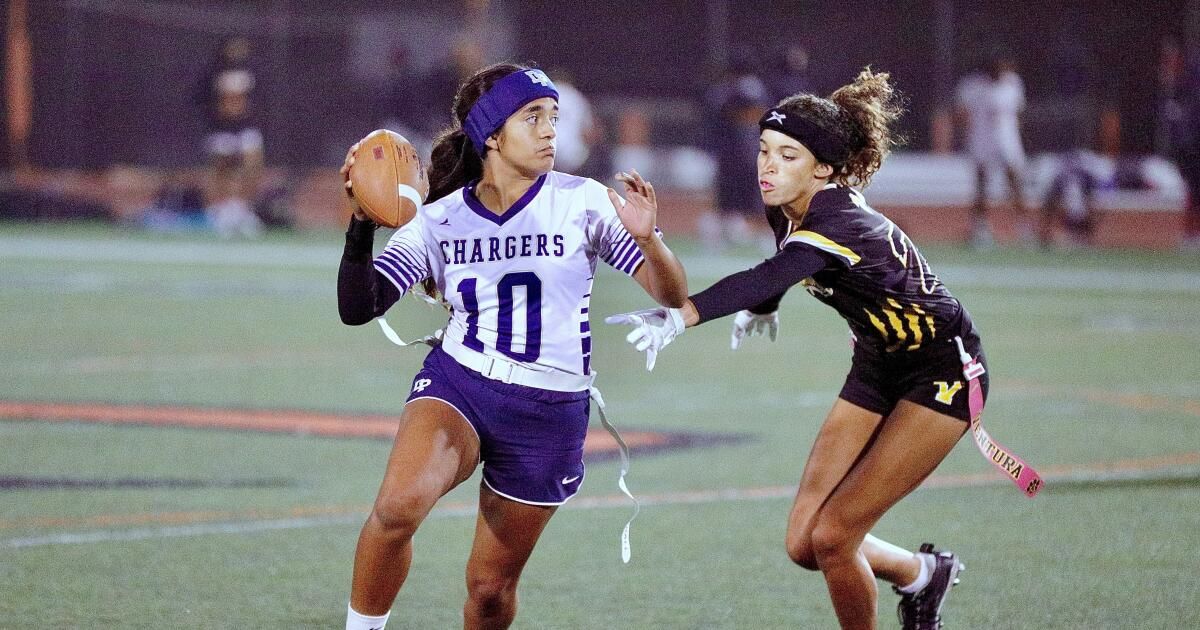As summer becomes autumn, Approximately 1.2 million American teenagers adapt to playing high school football. But something is changing in this annual autumn rite. Tens of thousands of those young athletes are now girls, and no shoulder blade or helmets will be played because they are not playing football of rigs.
“All eyes are in the flag football as The next emerging sport“For girls, according to Karissa Niehoff of the National Federation of Secondary Schools. By 2024, Niehoff pointed out, 11 states (including California) had sanctioned the flag football competition for high school girls, while another 17 had launched pilot programs. Given how girls are now going to sport, it is a safe bet that will be stamped to offer football for the girls.
The explosion of enthusiasm for the football of the flag of the girls has led some to wonder why girls do not play rigging football, such as boys. As a scholar who has studied gender and sports Since the 1980s, I am interested in how girls and boys sports have historically developed along parallel but different tracks, and what are the similarities and differences in girls and children's sports on our current gender relationships and beliefs.
The simple response of why most high school girls are channeled to flag football seems to be that people see rig football as too violent and too dangerous for girls. But it is not only the football of the girls that receives a special treatment: there is a long history in which the rules of the sports of girls and women have adapted and limited to accommodate the supposed physical limitations of girls and women. Children play baseball; The girls play softball (despite a deep Girls and Women's Baseball History). And as Lacrosse's game has expanded in American secondary schools in recent years, the complete contact game of children requires that players put helmets and protective equipment in their hands, arms and shoulders, while girls, protected by rules that limit contact, use only eye protectors and protective nozzles.
Critics say that flag football and other sports adapted for Girls Echo surpassed protective labor laws that treated women as “the weakest sex”, which forbids them to participate in positions of greater status in public life. But too often another question does not agree. If we know that rigging football is dangerous for girls, and now we understand the Human costs of playing football – How every 2.6 years of playing football Duplicate the possibilities of developing degenerative brain disease CTE, how to play rigging football seems to make a person It is more likely to develop Parkinson's disease – Why do we tolerate this game, we even celebrate it, for children?
In a moment of feminist progress for girls and women, we have not yet thought so deeply about The health hazards of close forms of masculinity for children and men. Children are still taught too often to inflict pain to others, since they are rewarded by Ignoring or even celebrating their own injuries. AND THE PUBLIC FOOTBALL CELEBRATIONFor athletes and for fans, it is a national pedagogy through which children internalize this self -destructive belly of patriarchy. In addition, the long -term health costs of playing football are disproportionately paid by young working class men.
American secondary schools are deeply invested in football, emotionally and financially. I saw this in my analysis of 120 years of sports, cheers and student life In Salinas High School, in Central Coast California. In that school and throughout the country, football remains in the center of a complex ritual: welcome celebrations and demonstrations of the entire school led by Porristas, exercise teams and marching bands, which anchor powerful traditions through which students, faculty, students and community members celebrate a collective identity. Keeping these traditions requires investments on time, work, emotion and a lot of money to pay the maintenance of the stadium, maintenance of the grass, coaches, travel, uniforms and other teams for hundreds of athletes and soccer coaches on each campus.
Given this civic investment in children's rigging football, it is not surprising that difficult questions about the health costs of playing are routinely. But this was not always the case. The beginning of the twentieth century was a moment of considerable turbulence in high school sports. In 1911, and echoing similar developments at Stanford University and UC Berkeley, Salinas High School left football for rugby, a game that was considered less fogged by the game, spectator violence, violence in the field, injuries and deaths that had increased nationwide in 1909.
The return of football to the campus after World War I, again, after the leadership of Stanford and Cal, was colored by the militarization of physical education, Driven by postwar anxieties on the alleged lack of hardness of the recruits of the army. In the 1930s, the “football hero” had become the masculinity model on the campus. In the postwar years, fed by the emergence of television and the fears of the cold war of the feminization of US children and men, football seized the land on the campus of the high school and the university and the university and the university He came to represent “the American lifestyle.”
Secondary school football, and its accompanying spirit rituals, remains a key link of group pleasure and collective identity. But the dangers of playing rigging football are filter into public consciousness. TO Article of 2023 Washington Post He examined how the growing public awareness of “the toll of a sport linked to brain damage” has contributed to a decrease in the number of children who play football. Meanwhile, According to NFHS Niemoff“The popularity of flag football, for boys and girls, has been growing at the youth level during the last 10 years. In 2023, around 500,000 girls from 6 to 17 years played flag football, an increase of 63% since 2019”.
Sometimes, when we think of gender equity, we ask the wrong questions, depending on the assumption that equity means that girls and women who strive to do what boys and men have been doing for decades. In this case, instead of asking why girls do not play rigs, More people begin to ask why children doWhile suggesting that it can be time to start moving children, starting with youth sports and extending to high school and high school, flag football.
Michael A. Messner is Professor Emeritus of Sociology and Gender Studies at USC Dornsife. His new book is “High school: Sports, Spirit and Citizens, 1903-2024”.












